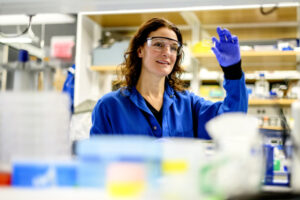Using Spark Fund Awards To Optimize Drug Delivery

ChE Professor Rebecca Carrier is using the Spark Funds from the Center for Research Innovation at Northeastern to develop an algorithm-driven, streamlined process for drug delivery to potentially reduce dosages and side effects.
Improving Bioavailability in Oral Drug Delivery — with Professor Rebecca Carrier
In many cases, oral drug delivery is a preferred method for medication administration because it is convenient and patient-friendly. Unlike injections or infusions, oral intake is non-invasive and requires no specialized equipment or medical supervision, offering patients autonomy in managing their treatment and increasing treatment compliance. With oral medications widely accepted and integrated into healthcare systems globally, they provide a familiar and accessible option for patients and healthcare providers alike.
However, it is estimated that 40% of compounds emerging from pharmaceutical and biotechnology discovery pipelines have low oral bioavailability and solubility and, therefore, may not be able to be delivered orally.
As a workaround for low solubility, lipid-soluble drug formulations can have a better bioavailability by several hundred percent. Despite decades of research, only 2-4% of commercial oral formulations incorporate lipid-based delivery because they tend to be resource-intensive, requiring extensive trial-and-error testing.
That’s why Professor Rebecca Carrier and her team at the Advanced Drug Delivery Research Laboratory (ADDRES Lab) have developed an algorithm-driven, streamlined process for designing optimal drug delivery systems to enhance the absorption of orally delivered compounds. They have developed a mechanism-based algorithm to reduce the need for trial-and-error formulation development with lipids by providing rational guidance on the most optimal quantities and types of lipids to achieve desired drug absorption kinetics.
“This process is a tremendous improvement over existing methods for designing drug delivery systems,” says Carrier, “which largely consist of resource-intensive trial-and-error testing and often do not identify optimal formulations for patient benefit.”
This work has earned them selection as one of the Fall 2023 Spark Fund awardees.
Algorithm-Driven Oral Drug Development
 Carrier and the ADDRES Lab team have developed a mechanism-based algorithm to reduce the need for trial-and-error formulation development with lipids. The algorithm predicts how different lipids will impact the bioavailability of a drug, providing rational guidance on the most optimal formulation properties needed to achieve the desired pharmacokinetics.
Carrier and the ADDRES Lab team have developed a mechanism-based algorithm to reduce the need for trial-and-error formulation development with lipids. The algorithm predicts how different lipids will impact the bioavailability of a drug, providing rational guidance on the most optimal formulation properties needed to achieve the desired pharmacokinetics.
The researchers have tested the approach using simple lipid formulations and model drugs in laboratory settings.
“We have demonstrated proof of concept that we can design a formulation that reduces the required drug dose by more than half with similar bioavailability,” says Carrier.
Now, the team is building case studies to demonstrate proof-of-concept for designing formulations with targeted pharmacokinetics for drug compounds with potential for commercialization. They strive to develop improved formulations of available oral drug compounds to reduce adverse side effects and streamline dosing.
The technology has the potential to significantly streamline the drug development process, likely allowing oral dosages of drugs that may otherwise require injection or allowing lower doses of compounds that are costly or have local GI side effects.
The software is also a significant advancement over any currently available solutions, as it can capture drug interactions with other agents in drug delivery systems that other software solutions cannot.
Commercialization with the CRI
Carrier’s work has been in development for over 20 years at Northeastern. She credits the support of the university as being instrumental in developing the processes and algorithms on which the technology is based.
“The CRI has been incredibly supportive of translation of our technology from the beginning,” says Carrier. “They have helped protect intellectual property, given guidance on potential commercialization paths, and put us in touch with multiple advisers and experts who have given invaluable advice on numerous topics. We are so grateful.”
A startup company based on this technology, MechaSim, was founded by a previous graduate student. This translation of the science from the lab to industry has helped enable the technology’s practical use in designing drug delivery systems.
Throughout this journey, Carrier remarks that taking a technology and developing a company has been different than she imagined.
“In my mind, we needed to have our technology completely validated and thoroughly tested in the context of different drugs and benchmarked against existing technologies prior to starting a company,” says Carrier. “What I have found, however, is that there is a trade-off between perfecting the science and moving forward with translation. We all could spend forever perfecting the science, and perhaps if we don’t, that means the product is not the absolute best it could be at that moment, but a leap of faith needs to be taken to at least get the ball rolling towards creating a product.”
Awards & Funding
Northeastern CRI’s Spark Fund partly funds this technology, as the team was selected as one of the Spring 2023 Spark Fund awardees.
The team will use the funds from the Spark Fund given by Northeastern’s CRI to gain essential data demonstrating the ability of the technology to design real-life drug delivery systems that would be highly useful to a pharma or biotech company. The team has also been able to hire a postdoctoral researcher to advance the technology further.
“We are very grateful for the help that the CRI has given in identifying paths forward, answering our questions related to translation, and providing valuable resources,” says Carrier.
The team has also been awarded two government grants, one Small Business Innovation Research (SBIR) grant and one Small Business Technology Transfer (STTR) grant. The grants were from the National Science Foundation (NSF) and the National Institutes of Health (NIH), which helped enable their efforts to establish proof of concept.
Source: Elizabeth Creason, Center for Research Innovation